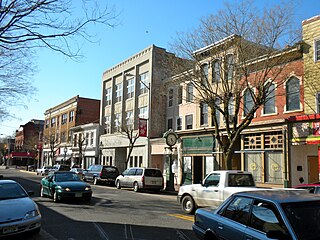
Mauricetown is a census-designated place and unincorporated community that is part of Commercial Township in Cumberland County, in the U.S. state of New Jersey.

Heislerville is an unincorporated community and census-designated place (CDP) that is part of Maurice River Township in Cumberland County in the U.S. state of New Jersey. It was named after the Heisler family, prominent members of the Methodist Episcopal Church established here in 1828.

List of the National Register of Historic Places listings in Cumberland County, New Jersey

The Southern Shore Region is located in the South Jersey region of New Jersey. It is one of six tourism regions established by the New Jersey State Department of Tourism, the others are the Gateway Region, Greater Atlantic City, the Delaware River Region, the Shore Region. and the Skylands Region. The area includes Cape May County and Cumberland County. The coast is along the Atlantic Ocean and Delaware Bay, while the inland areas are part of the New Jersey Pine Barrens.

Deerfield Presbyterian Church is a historic church in the Seabrook section of Upper Deerfield Township in Cumberland County, New Jersey, United States.

Beth Hillel Synagogue is a Jewish synagogue on Irving Avenue in Deerfield Township, Cumberland County, New Jersey, United States.

Old Broad Street Presbyterian Church and Cemetery is a historic church on Broad and Lawrence Streets in Bridgeton, Cumberland County, New Jersey, United States. It was built in 1792 and added to the National Register of Historic Places in 1974. The church and cemetery are also listed on both the New Jersey Register

The Bivalve Oyster Packing Houses and Docks are located along Shell Road in the Bivalve section of Commercial Township in Cumberland County, New Jersey. They were added to the National Register of Historic Places on February 28, 1996, for their significance in commerce and maritime history during the years 1870–1945. The listing includes five contributing buildings. The buildings were listed as part of the Marine and Architectural Resources of the Maurice River Cove Multiple Property Documentation Form (MPDF). The Bayshore Center, an educational museum, is located adjacent to the property at 2800 High Street.

Bridgeton Historic District is located in Bridgeton, Cumberland County, New Jersey. The district was added to the National Register of Historic Places on October 29, 1982.

Jeremiah Buck House is located in Bridgeton, Cumberland County, New Jersey, United States. The house was built in 1808 and was added to the National Register of Historic Places on December 30, 1975.

Caesar Hoskins Log Cabin is located in Mauricetown section of Commercial Township, Cumberland County, New Jersey, United States. The building is believed to have been built in 1690s by Swedes for Capt. Caesar Hoskins. It was added to the National Register of Historic Places on September 10, 1987.

Millville's First Bank Building is located in Millville, Cumberland County, New Jersey, United States. The building was built in 1857 and was added to the National Register of Historic Places on November 20, 1980.

Potter's Tavern is located at 49–51 Broad Street in the city of Bridgeton in Cumberland County, New Jersey, United States. Built in 1770, it was added to the National Register of Historic Places on September 10, 1971, for its significance in architecture, communications, and politics. The building was documented by the Historic American Buildings Survey (HABS) in 2003.

Samuel W. Seeley House is located in Bridgeton, Cumberland County, New Jersey, United States. The house was built in 1799 and was added to the National Register of Historic Places on May 13, 1976.

The Landis Theatre–Mori Brothers Building is located at 830–834 Landis Avenue in the city of Vineland in Cumberland County, New Jersey. The building was built in 1937 and its first movie was Hats Off. The theater serviced the USO during World War II, and the auditorium was twinned in 1980. After 50 years of service to the Vineland community, it closed finally in 1987, victim of declining revenue against the Demarco Cinemas nearby. Its last movie was House 2. It was added to the National Register of Historic Places on November 22, 2000, for its significance in architecture, engineering, and entertainment/recreation. It was designed by Philadelphia architect William Harold Lee, who designed several historic theaters. Renovation of the theater was completed in early 2010, and it officially re-opened on May 22, with Bernadette Peters being the opening act.
Deerfield Pike Tollgate House was located in Upper Deerfield Township, Cumberland County, New Jersey, United States. The house was built in 1853 and was added to the National Register of Historic Places on May 21, 1975. The house was demolished in 2001.

The Thomas Maskel House is located on Bacon's Neck Road near the Greenwich section of Greenwich Township in Cumberland County, New Jersey, United States. The building was documented by the Historic American Buildings Survey (HABS) in 1939. It was added to the National Register of Historic Places on June 10, 1975, for its significance in exploration/settlement.
Spindrift Sailing Yacht is located in Fairfield Township, Cumberland County, New Jersey, United States. The yacht was built in 1882 and was added to the National Register of Historic Places on April 22, 1982.

The Greenwich Historic District is a 350-acre (140 ha) historic district located in the Greenwich section of Greenwich Township in Cumberland County, New Jersey, United States. It extends from the Cohansey River north toward the neighboring settlement of Othello. The district was added to the National Register of Historic Places on January 20, 1972, for its significance in agriculture, architecture, commerce, and politics. It includes 19 contributing buildings, many documented by the Historic American Buildings Survey (HABS).




















